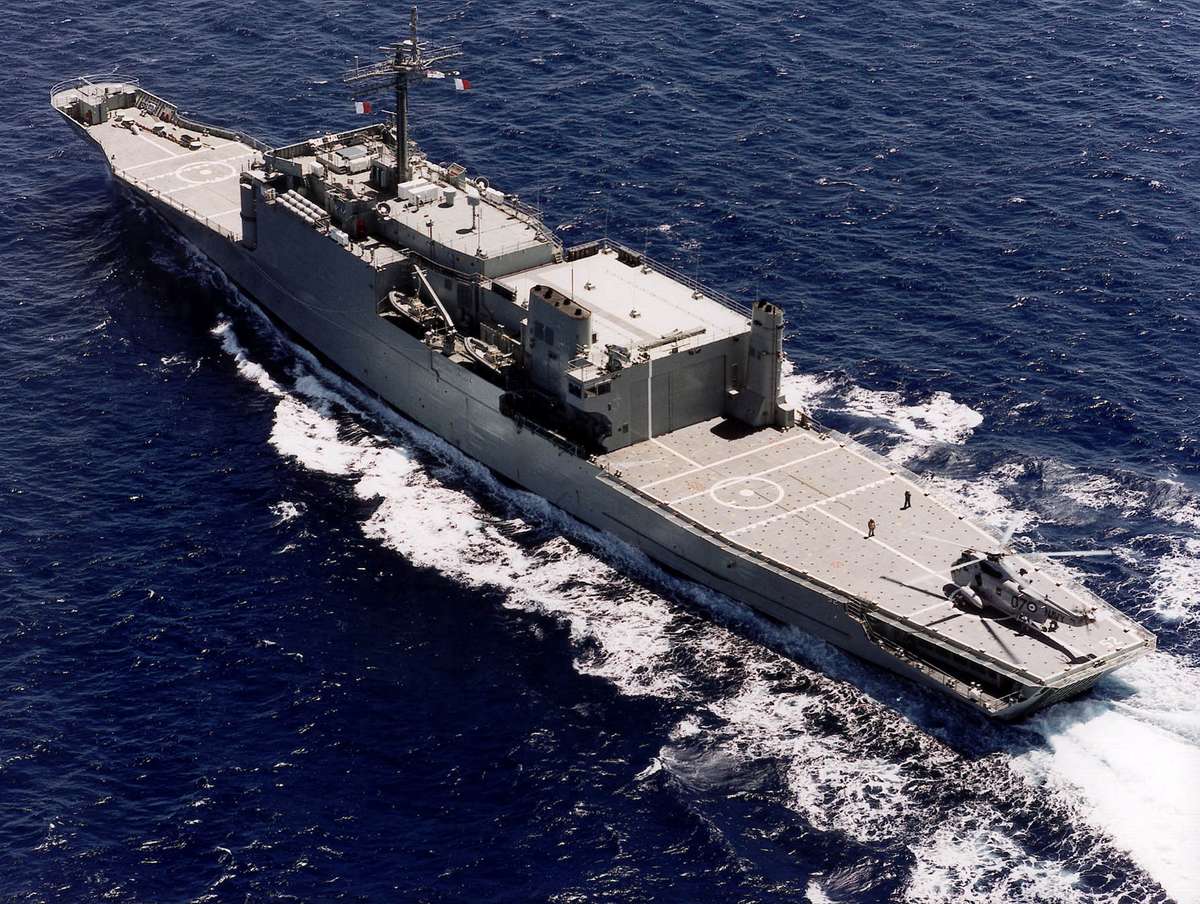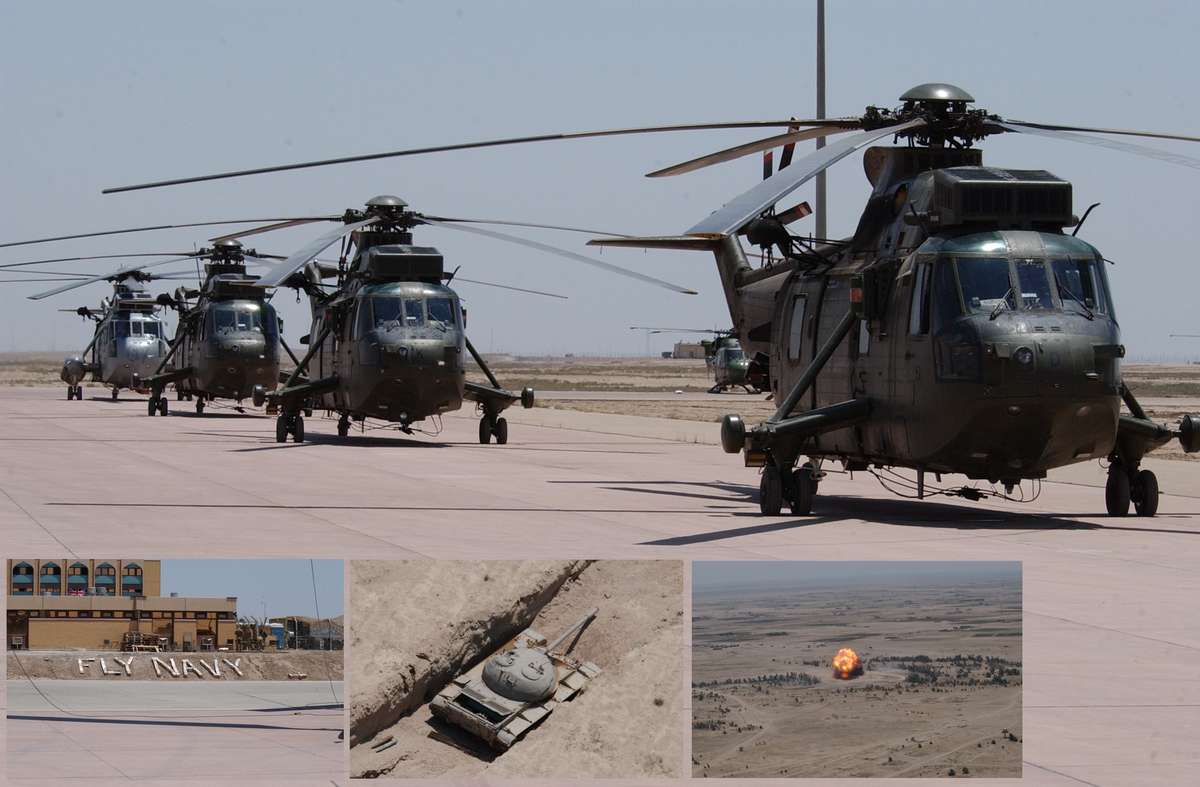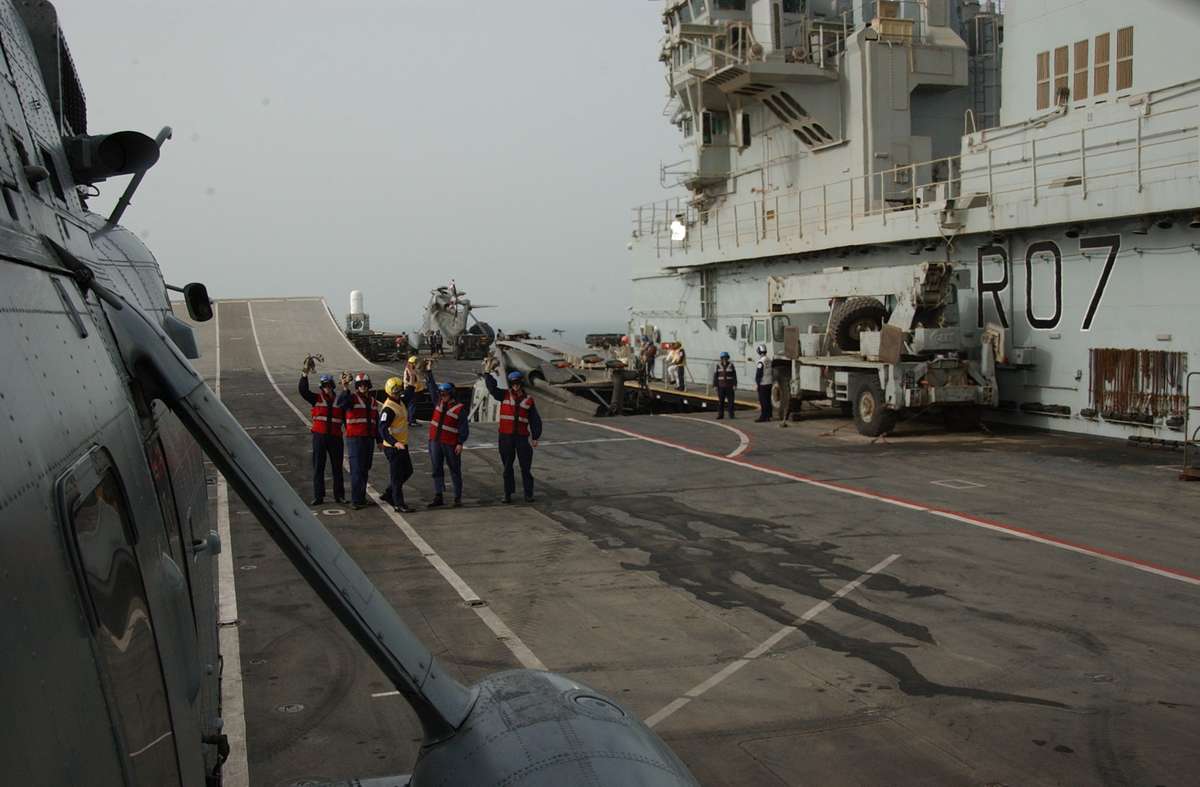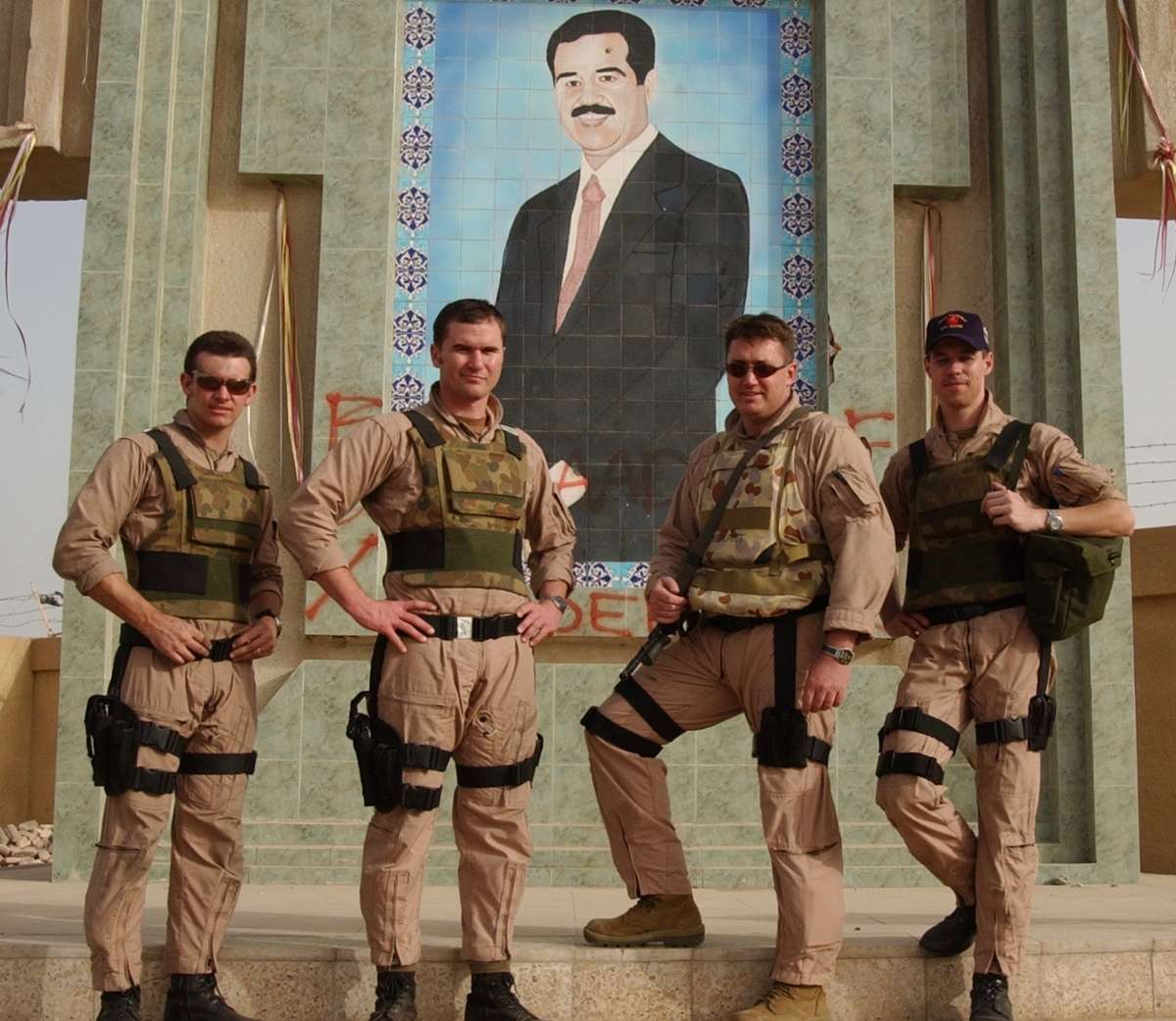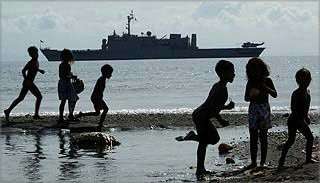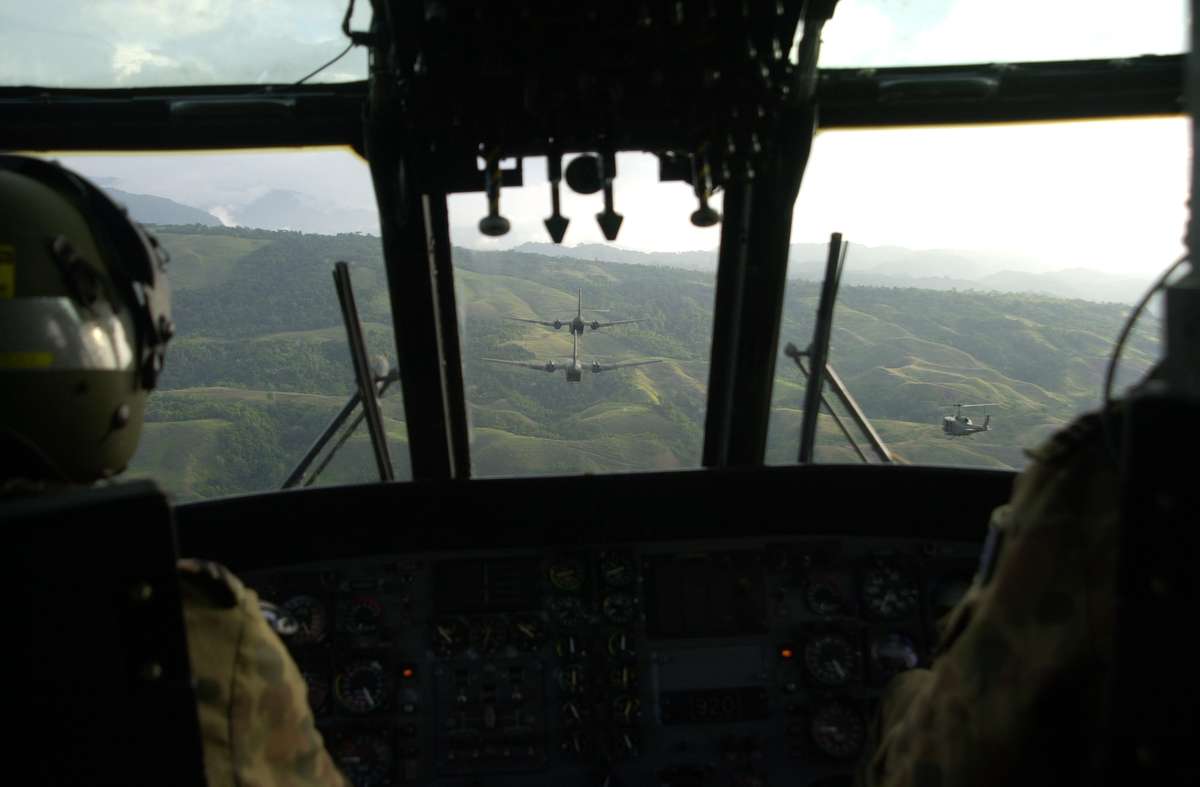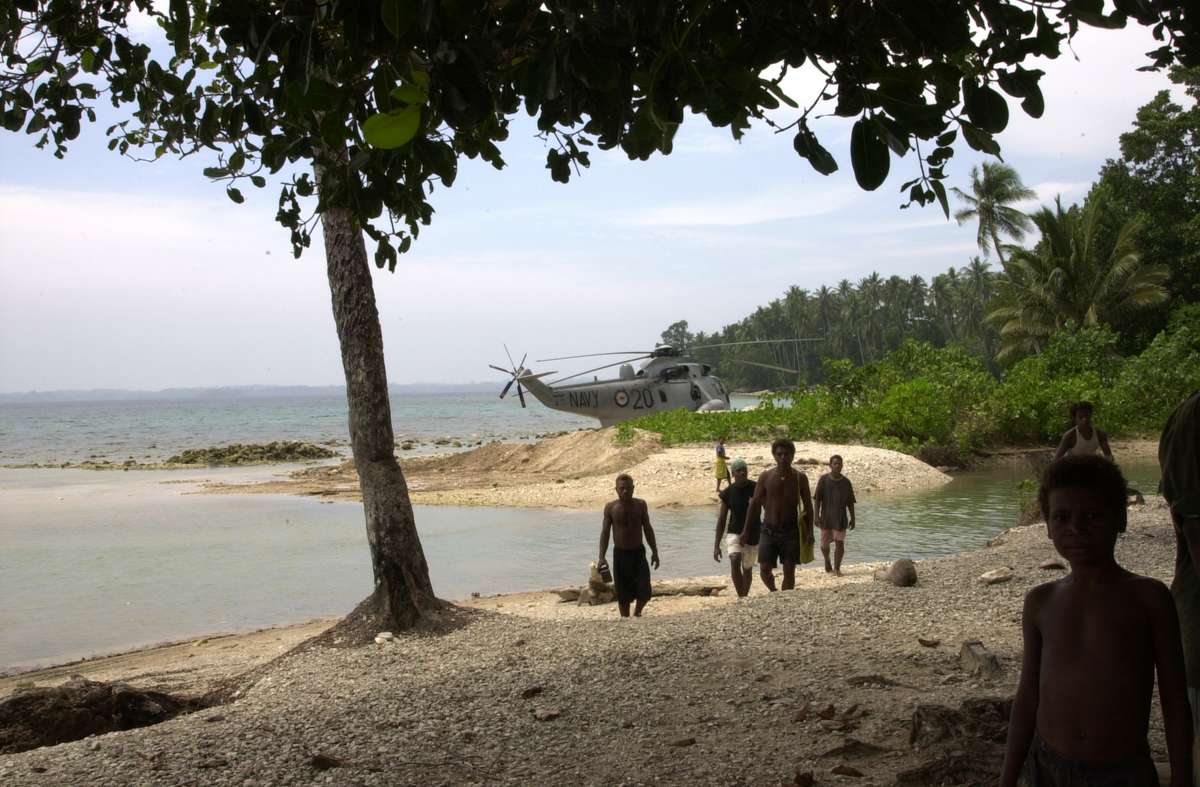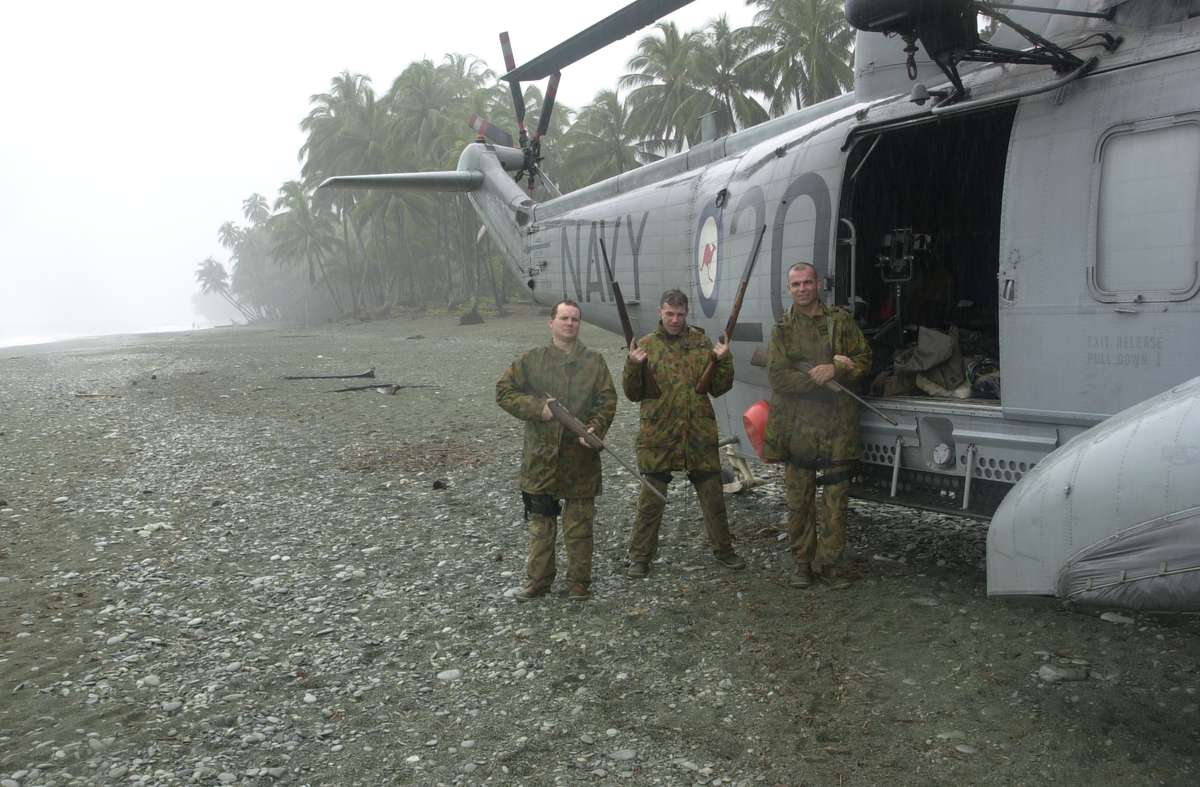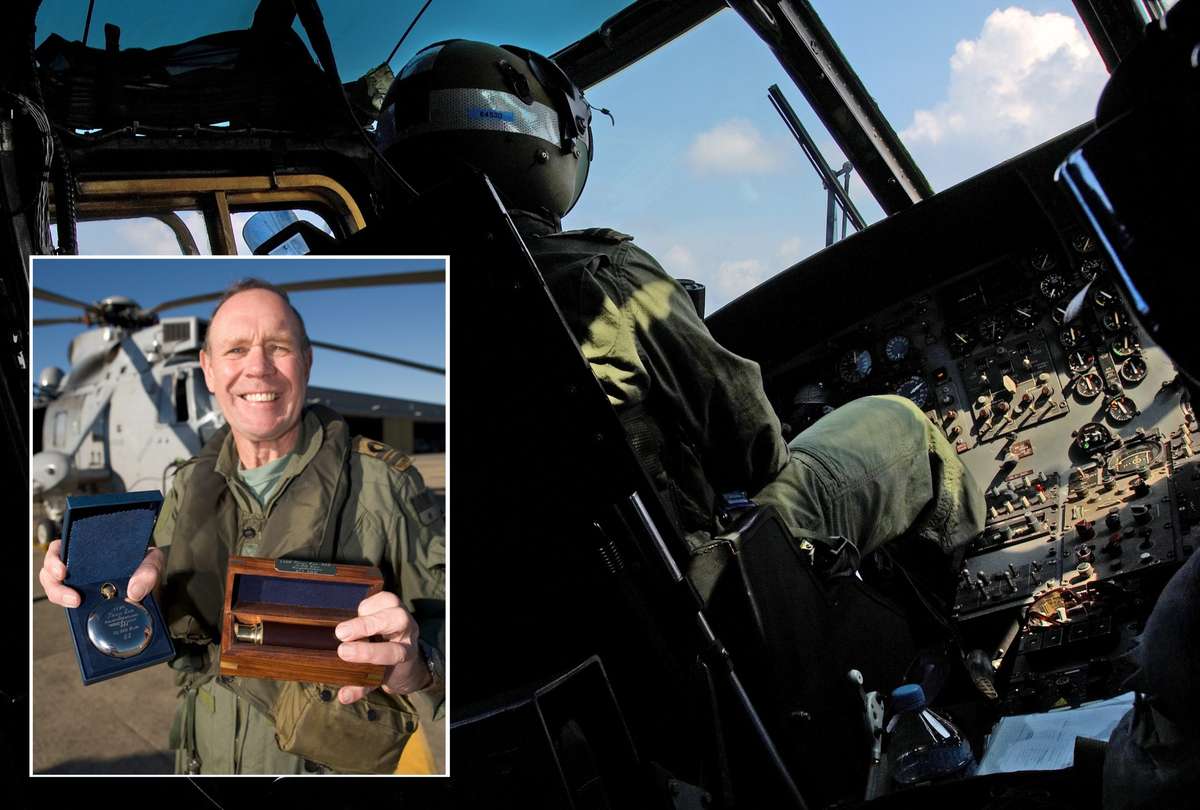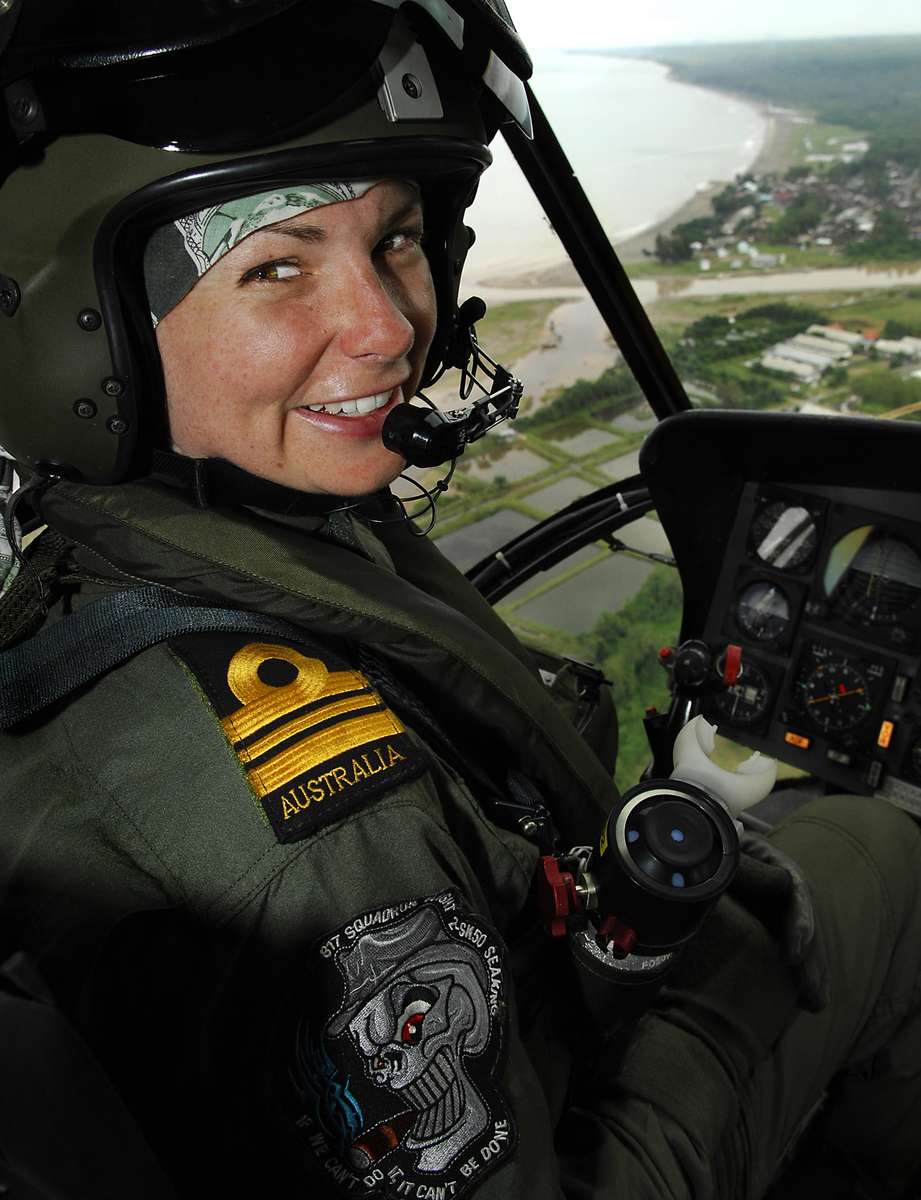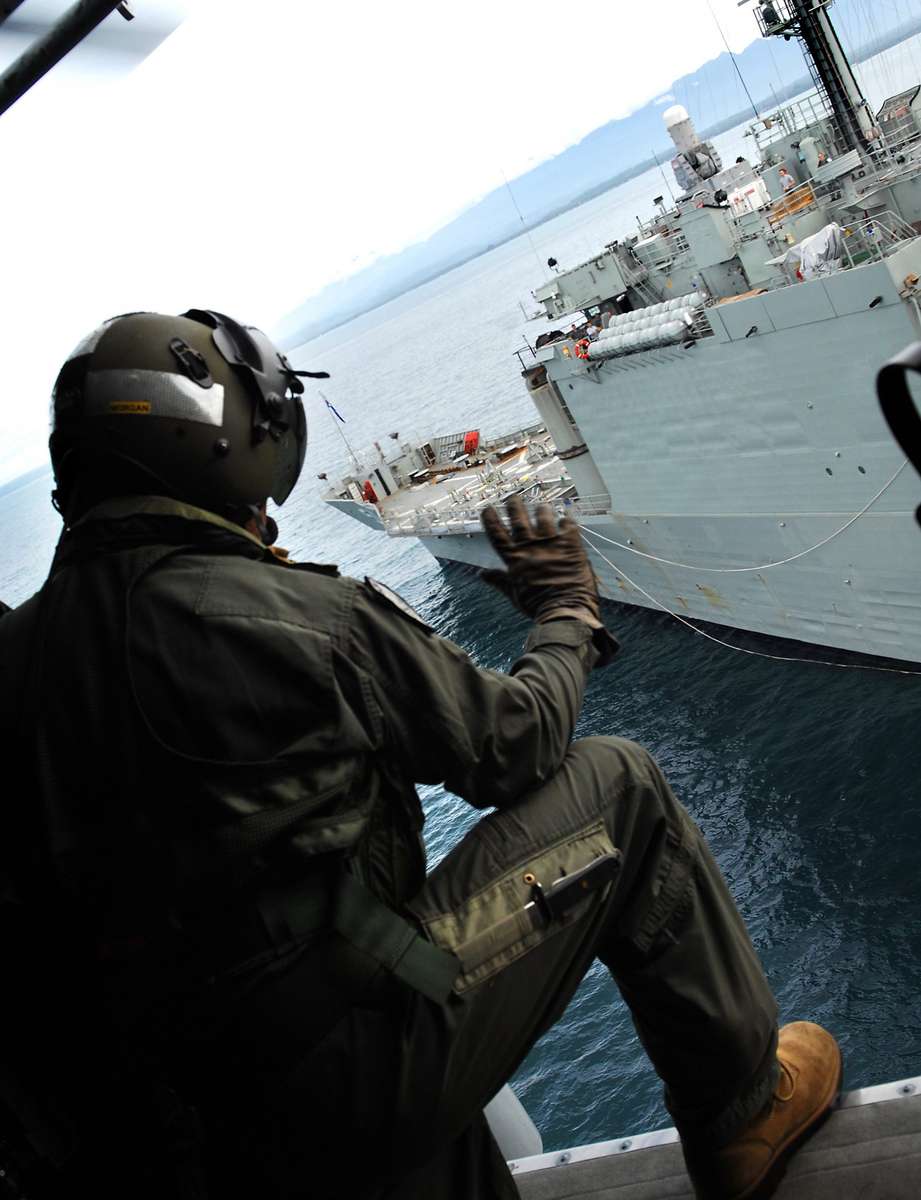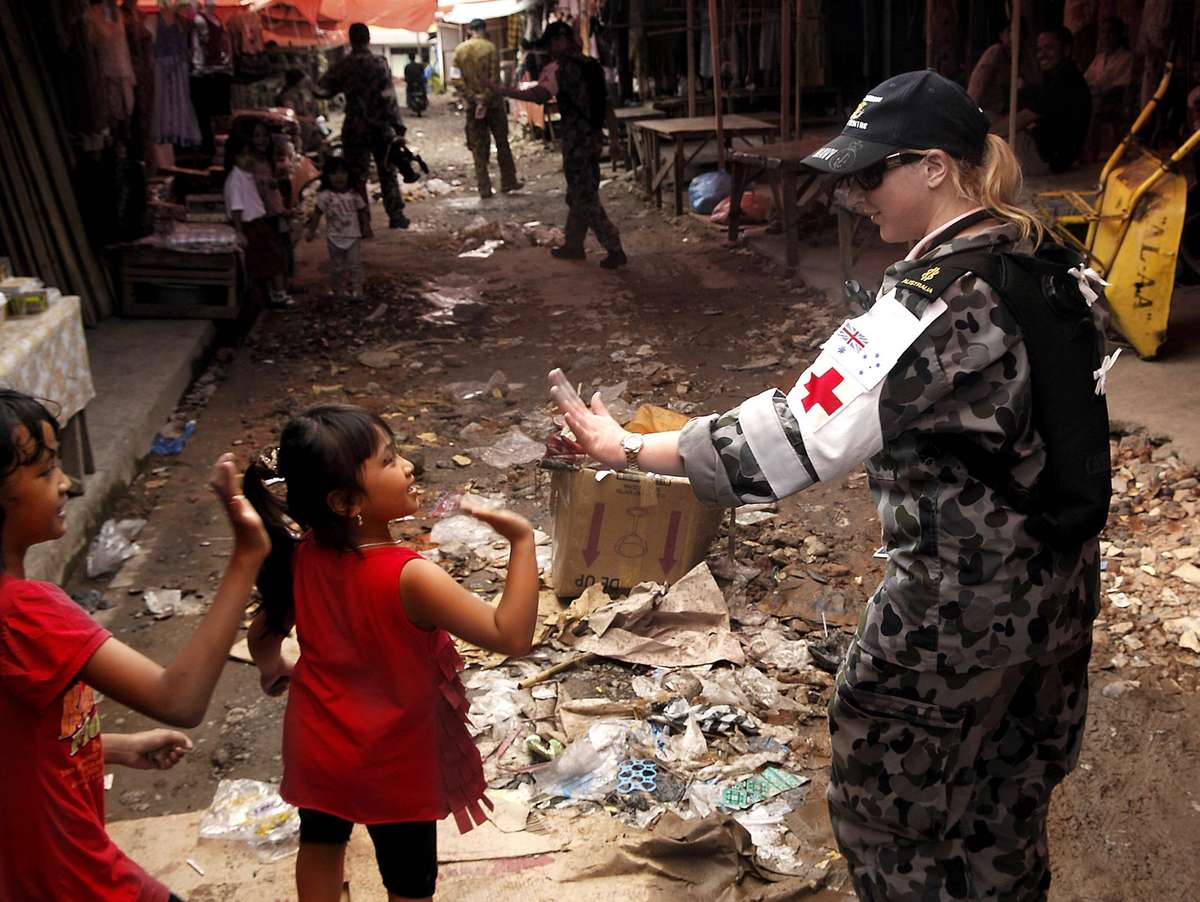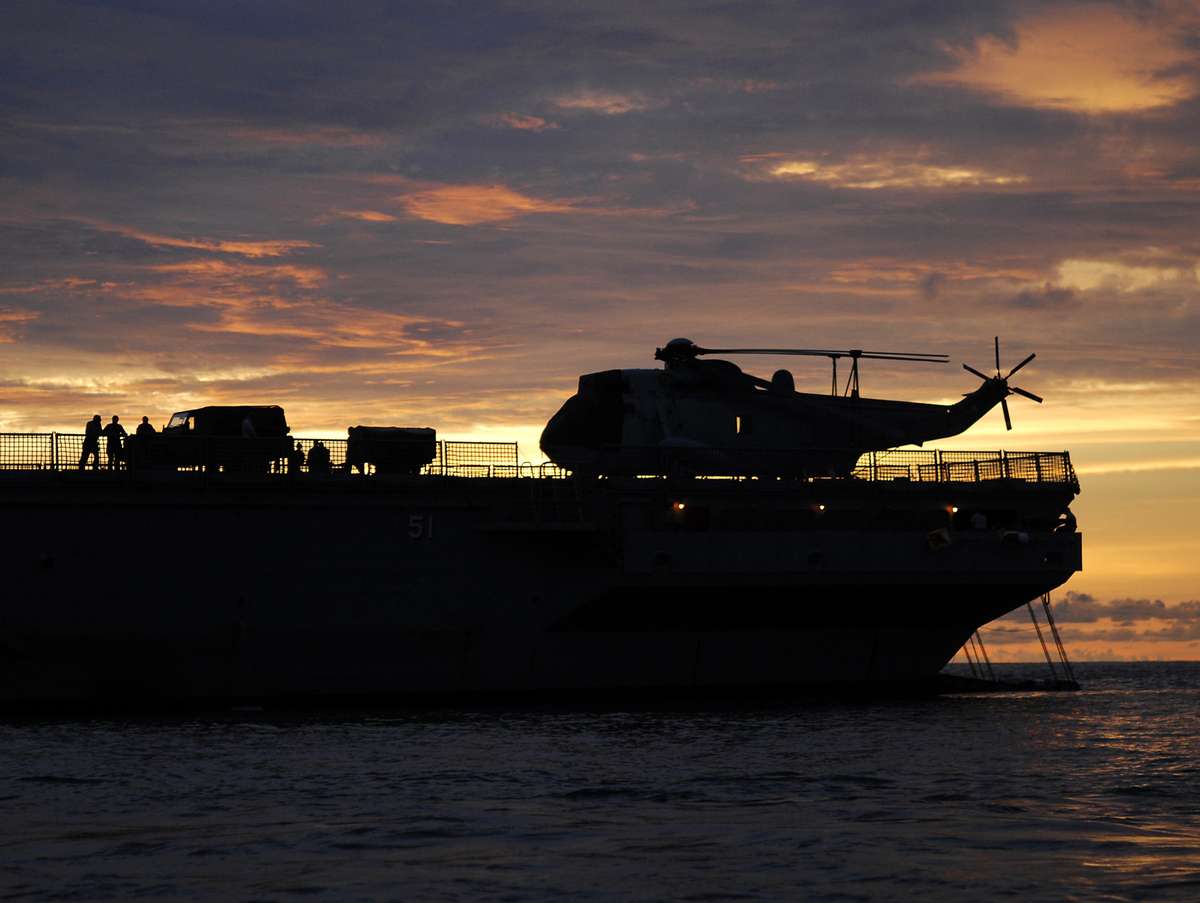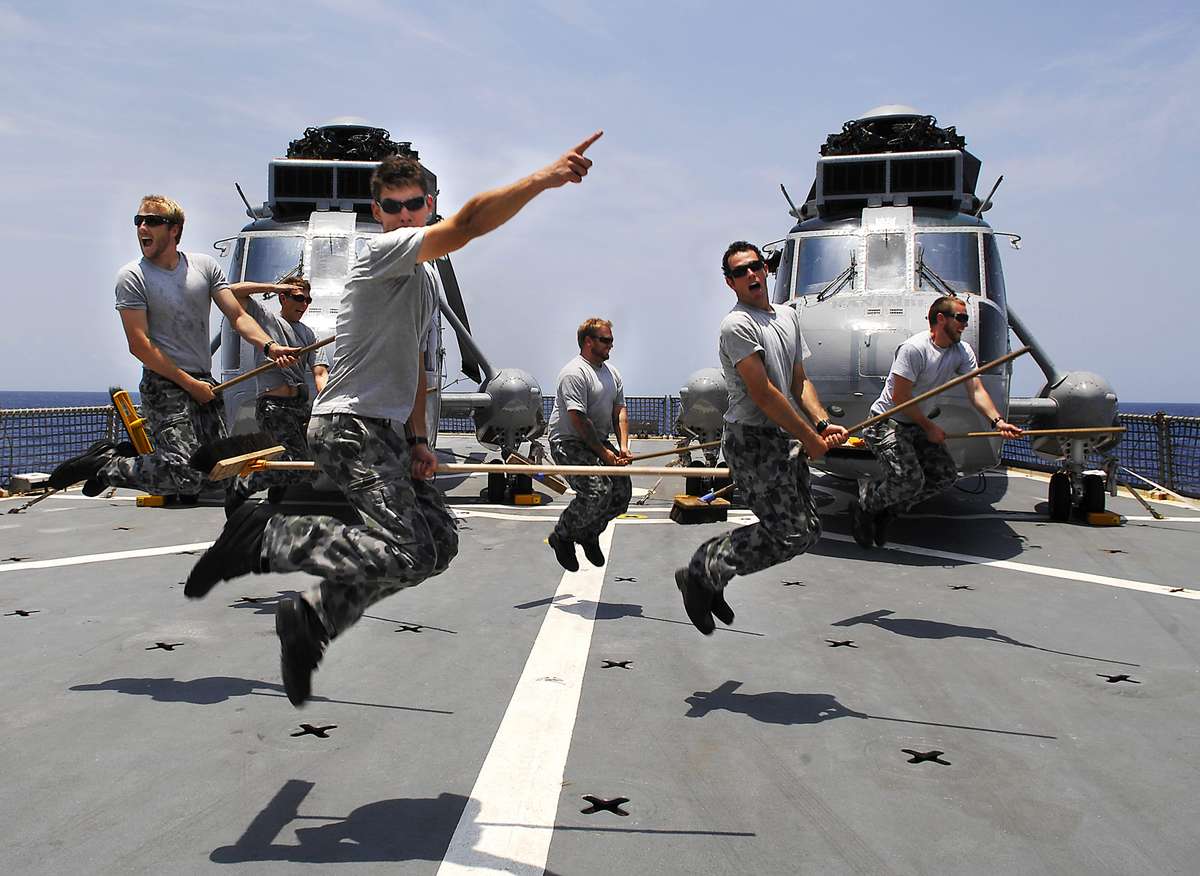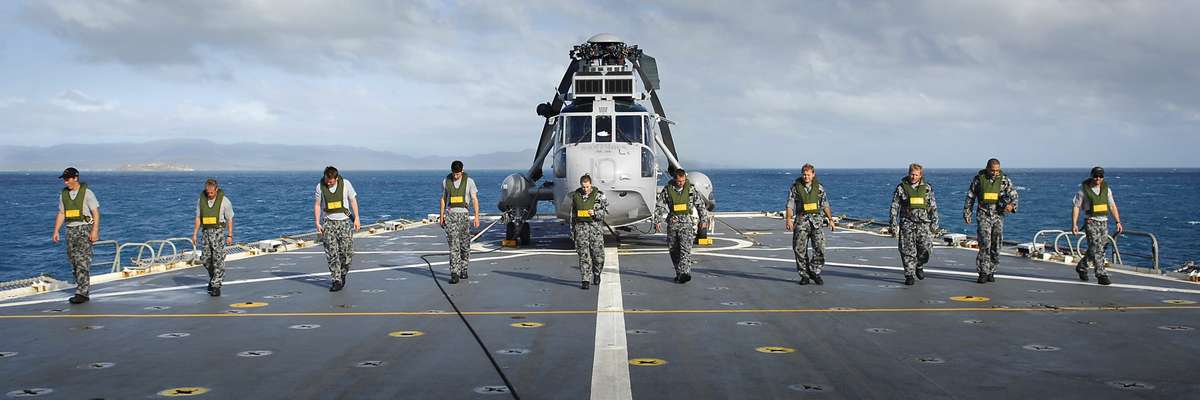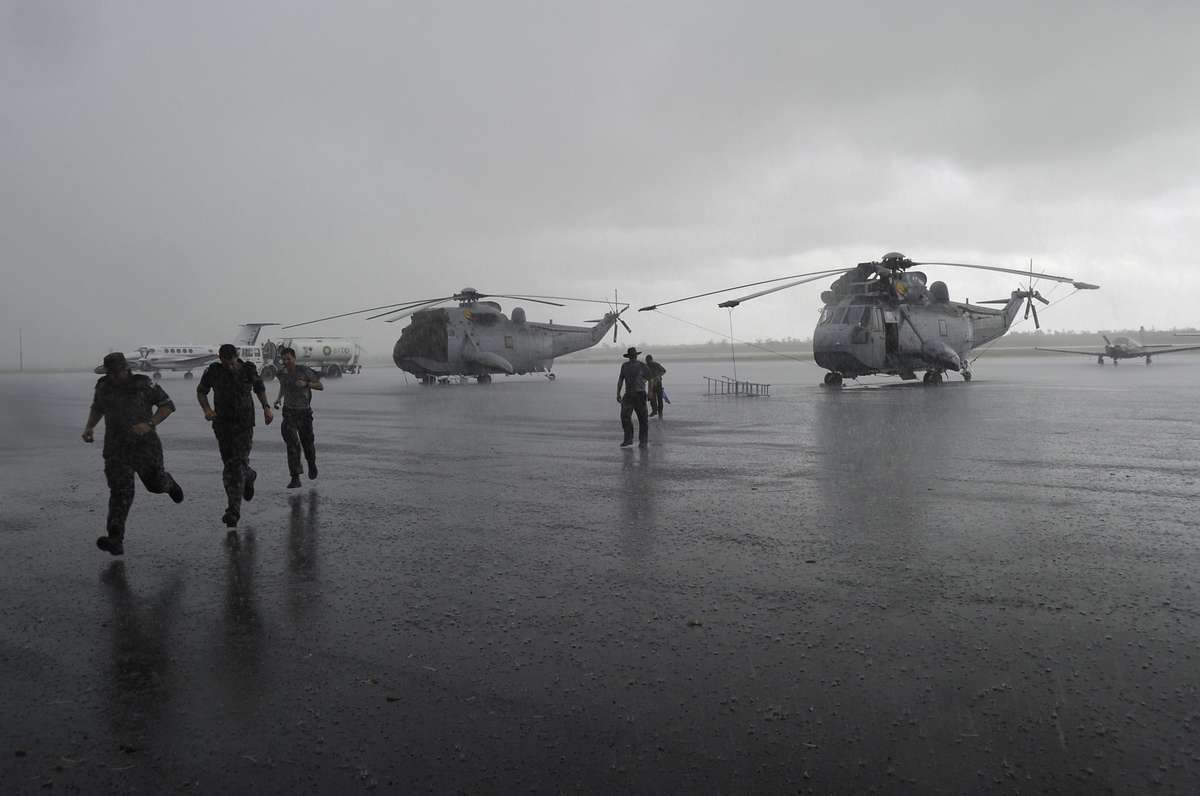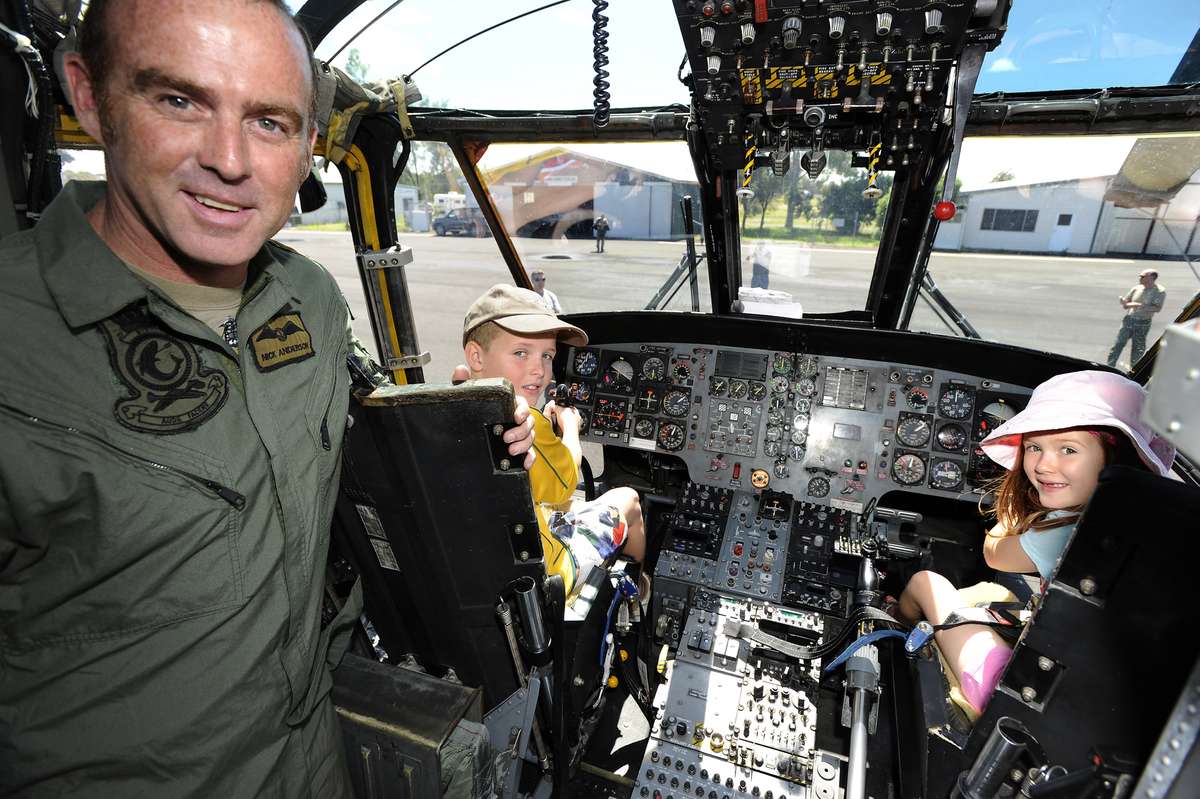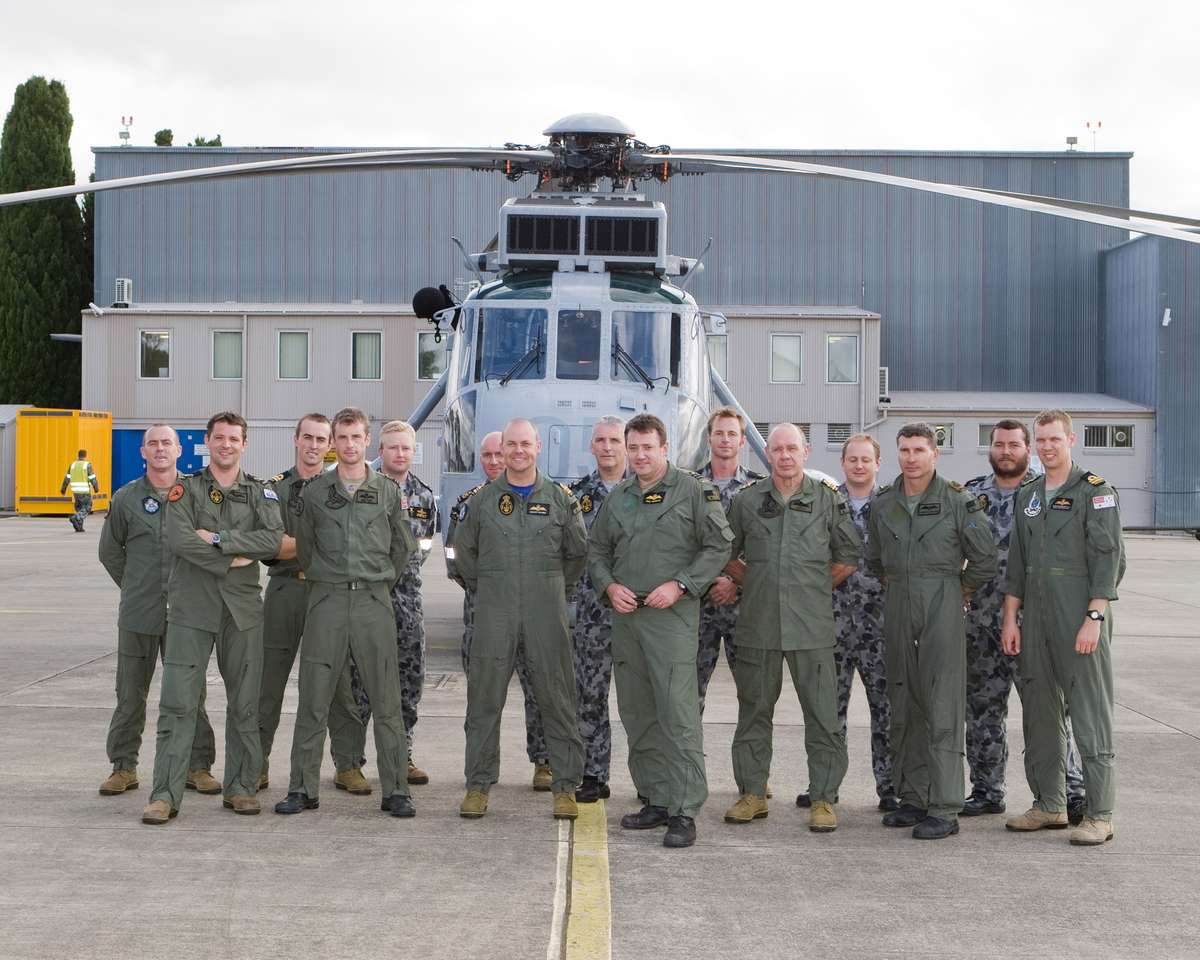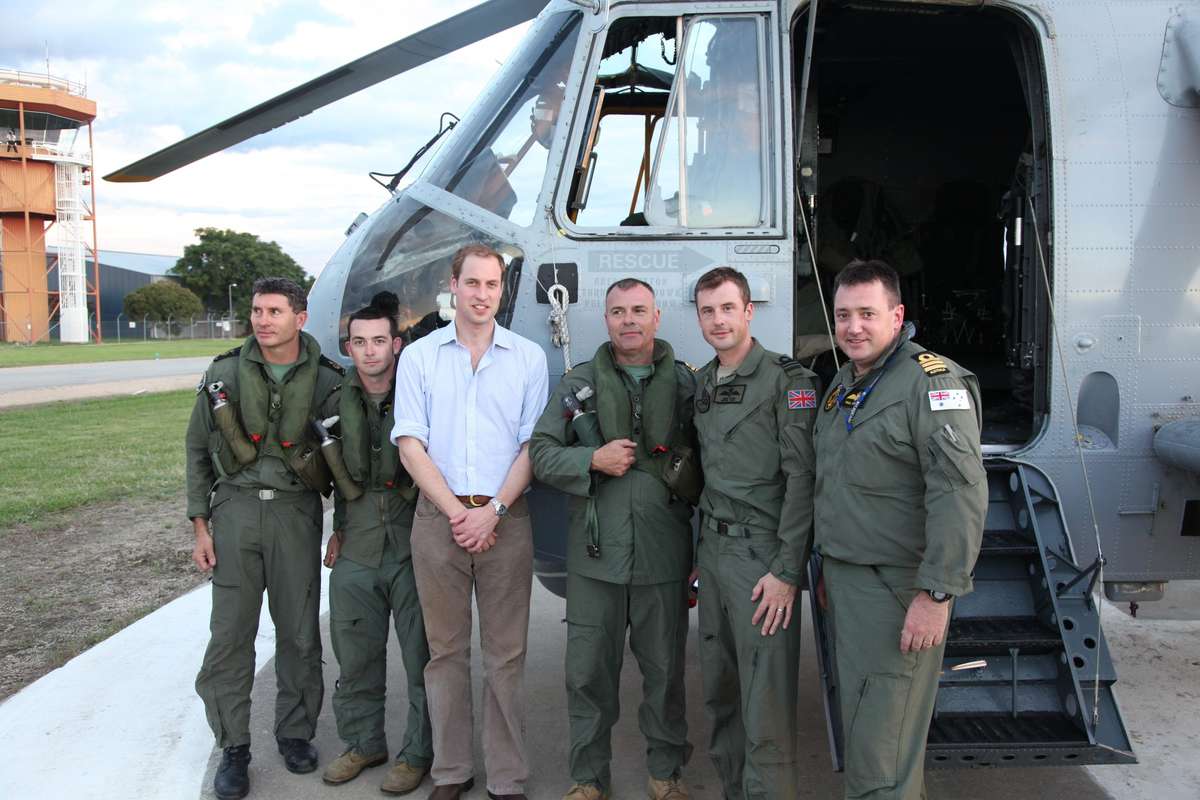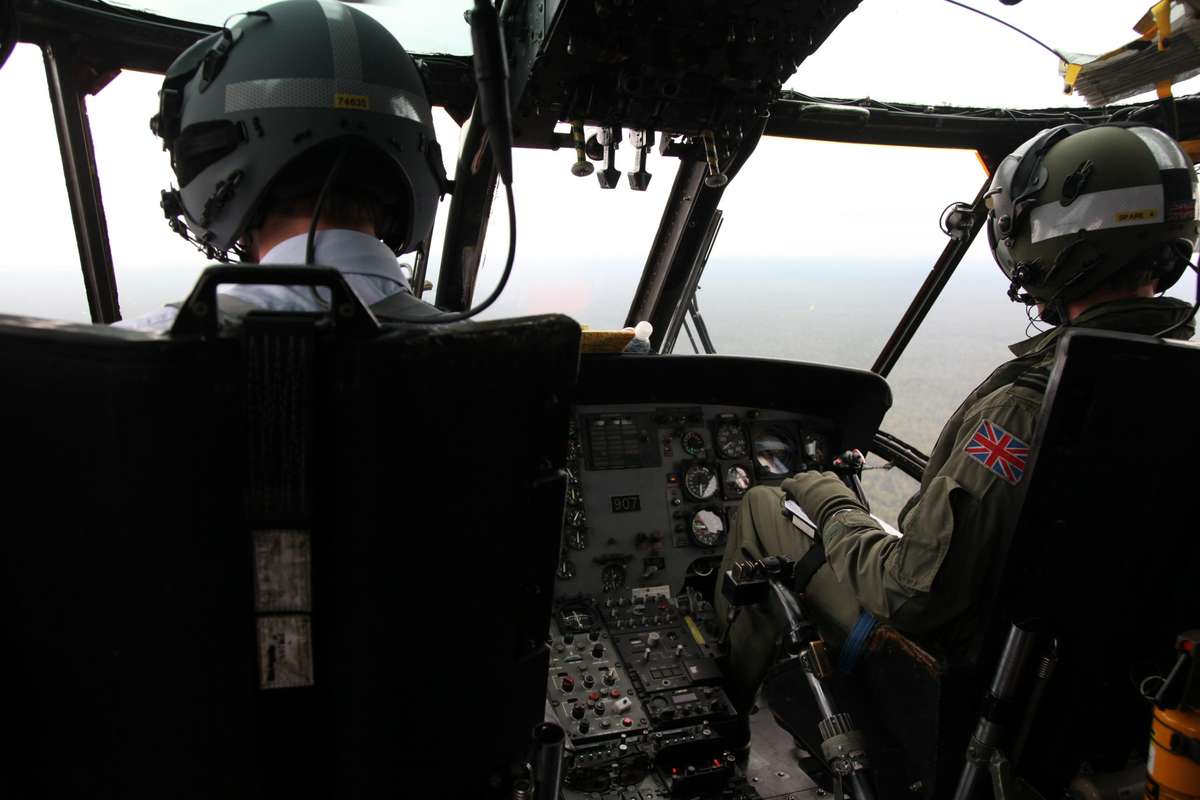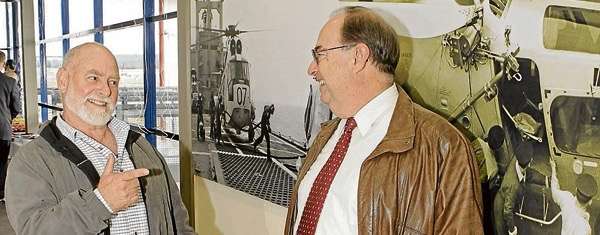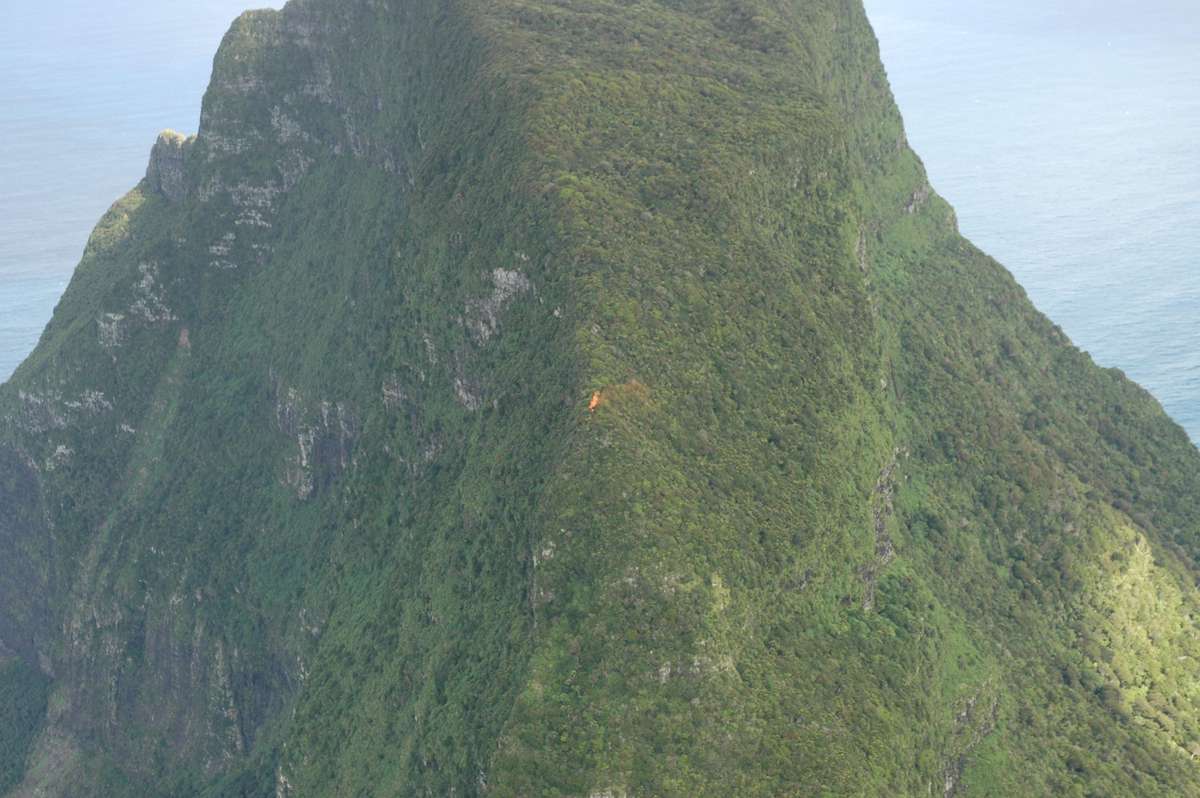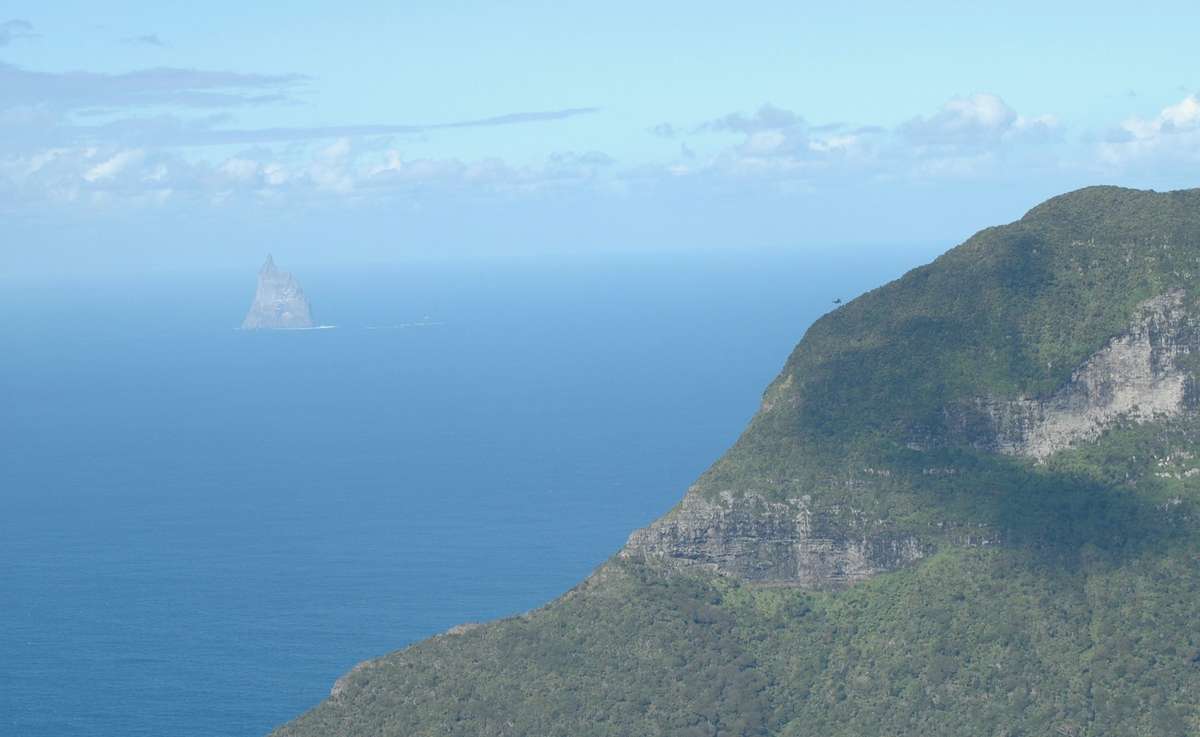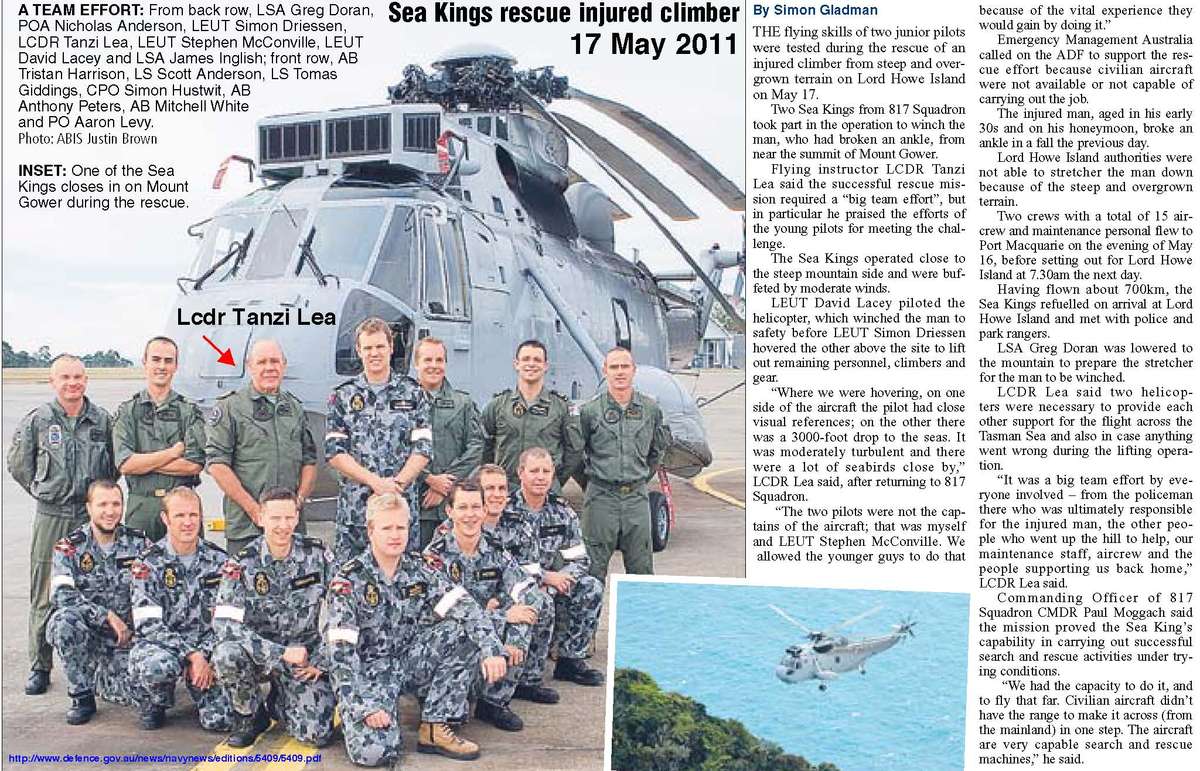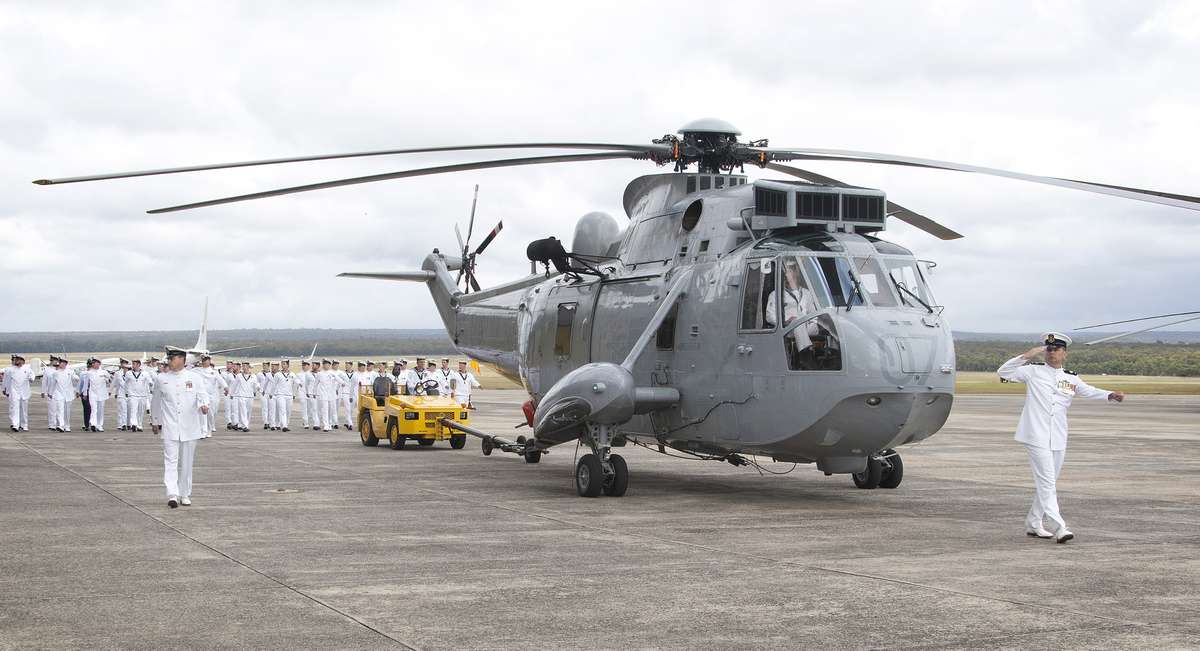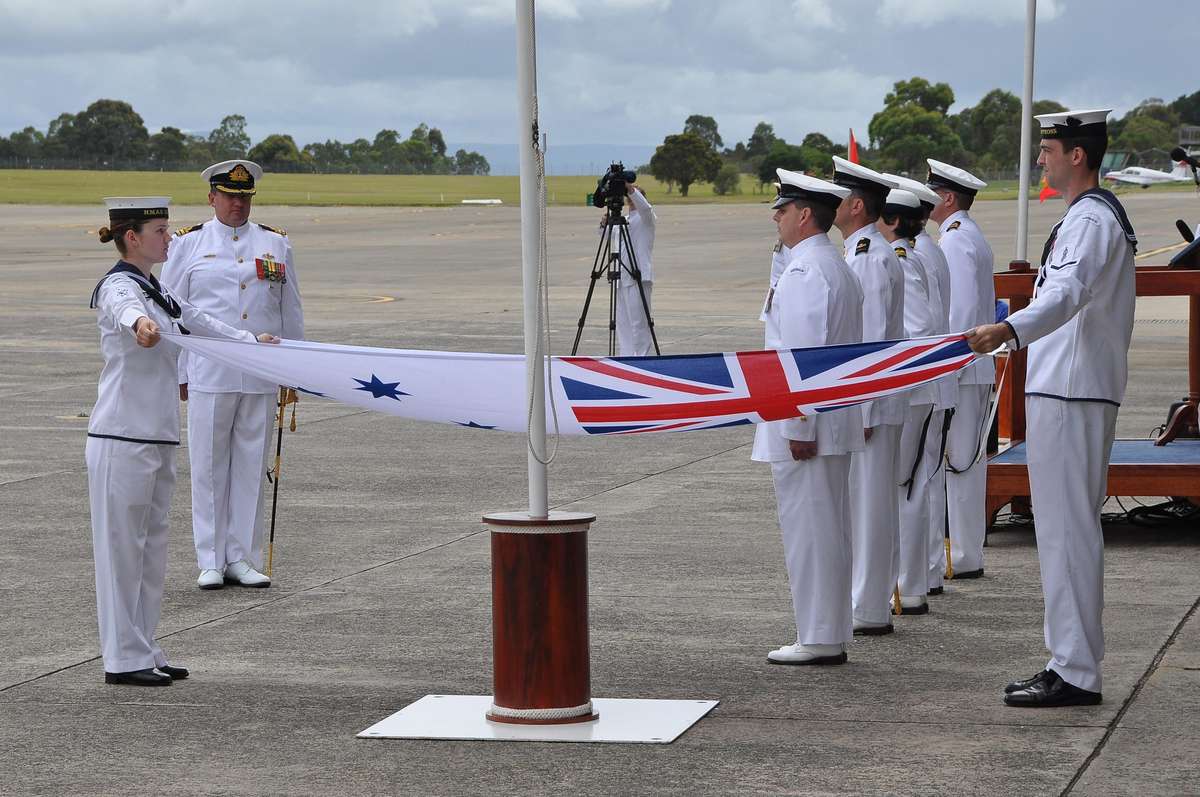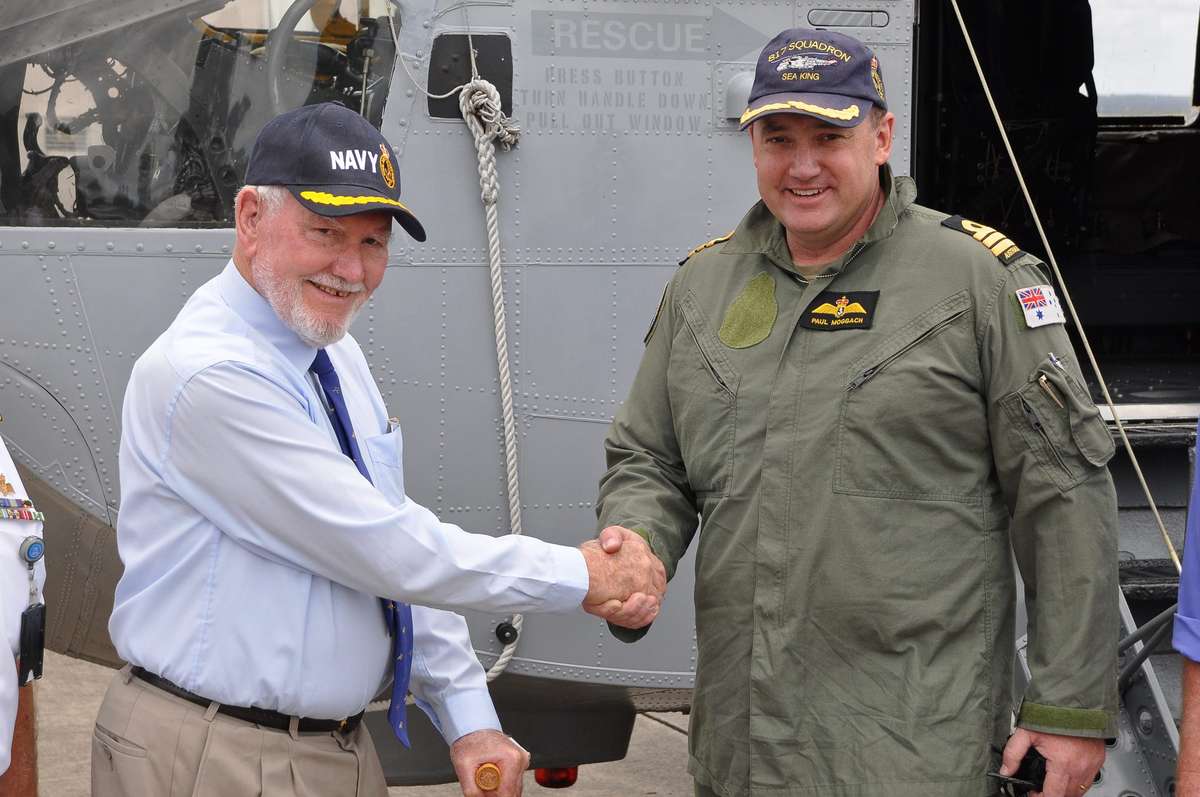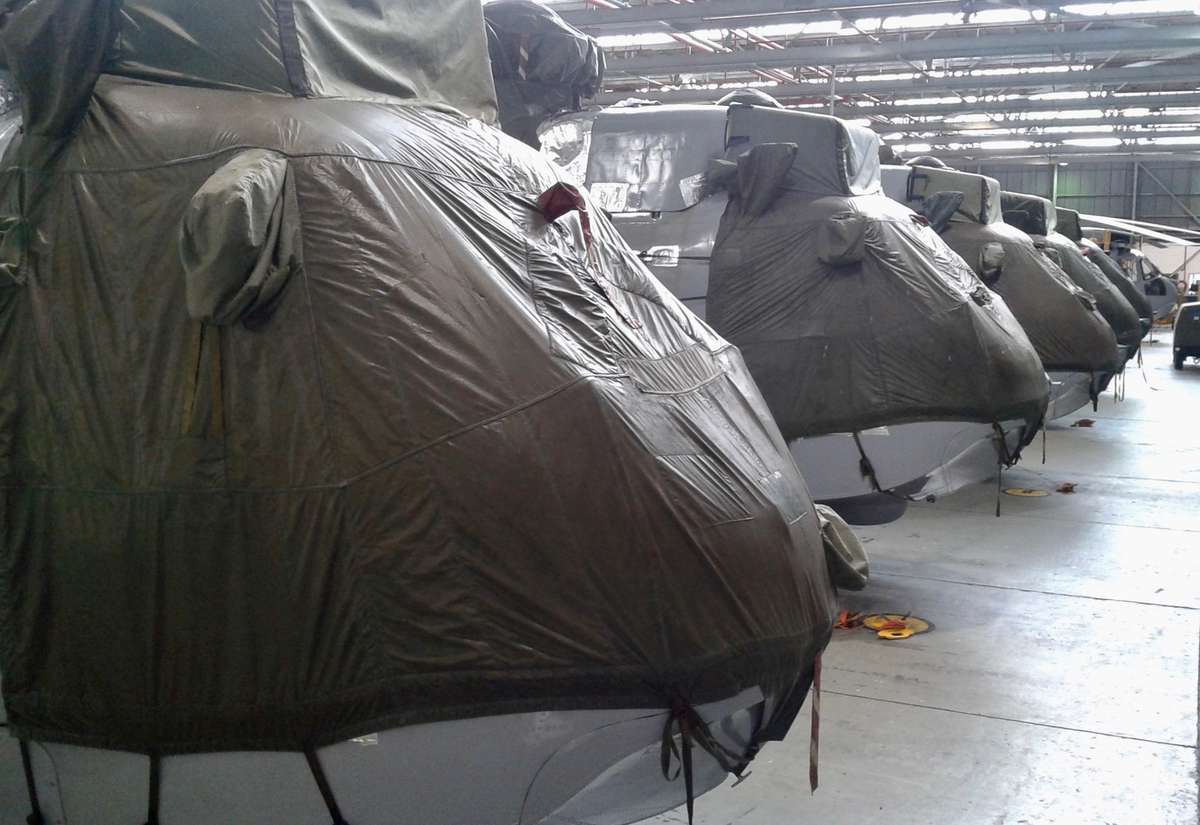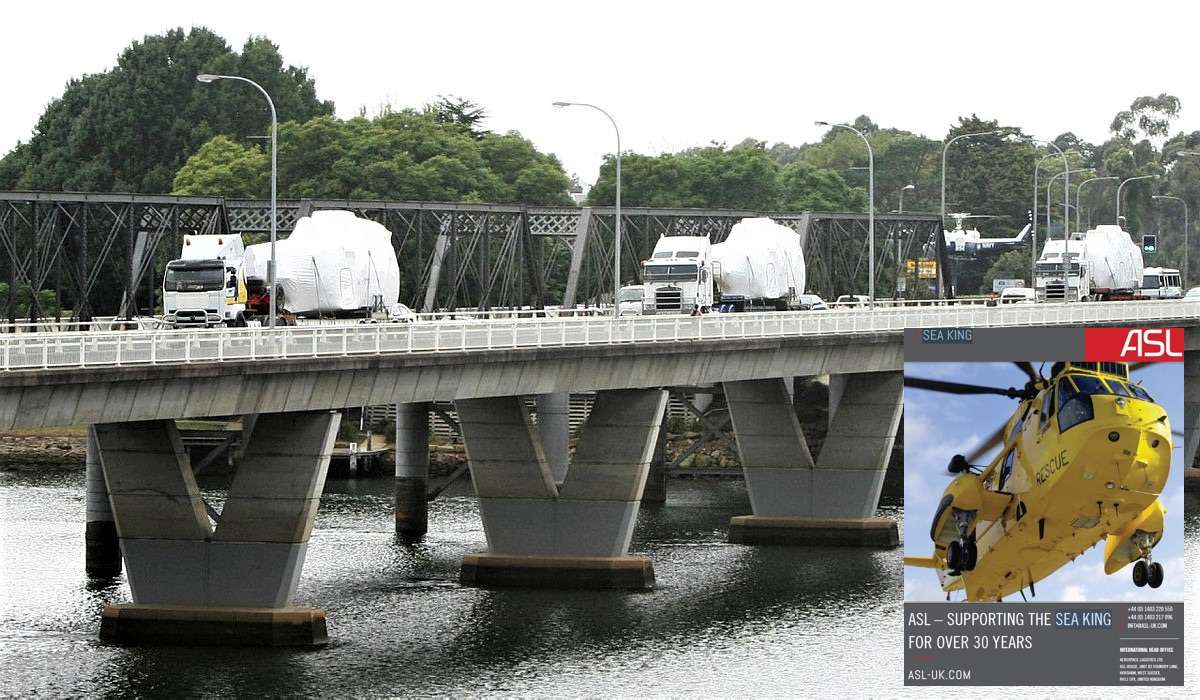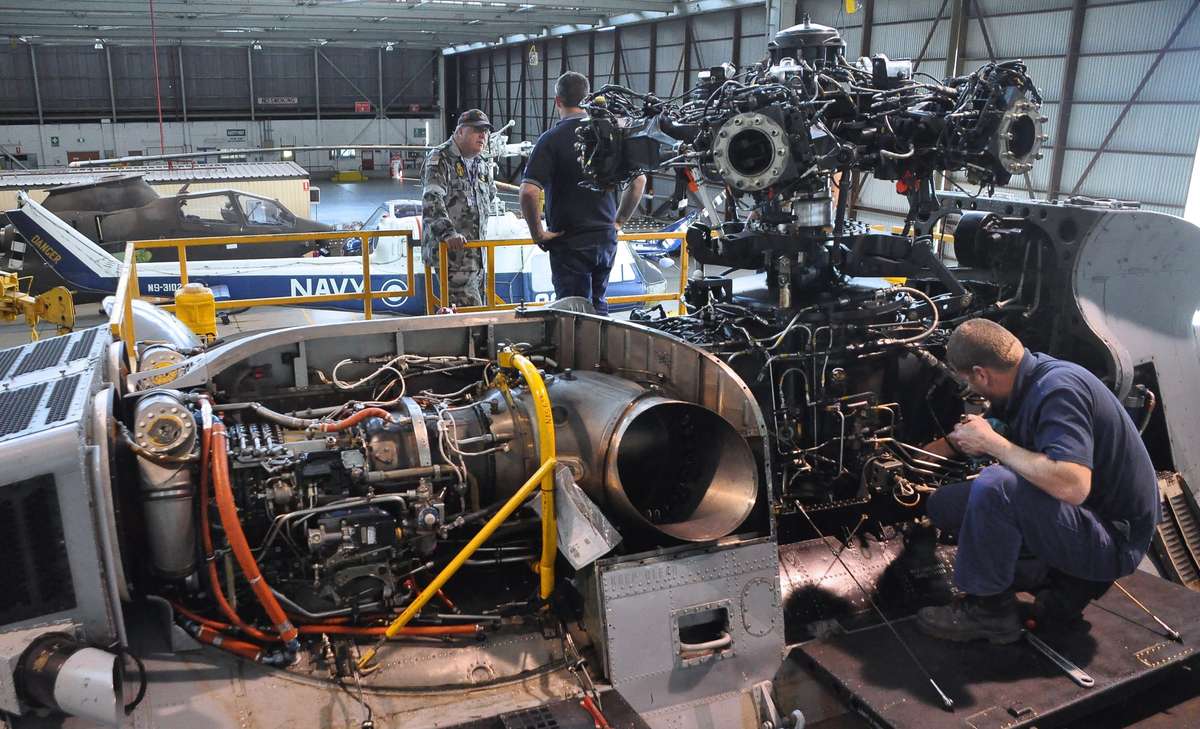In 1994 the RAN purchased two vessels which were to be inextricably linked to HS817s Sea Kings, but none more so than HMAS KANIMBLA. Like its sister ship MANOORA, pictured here, it was a former US Navy Tank Landing Ship of early 1970’s vintage, but the RAN saw it as a way to bolster its amphibious capability and brought the two ships to Australia in 1994. A full survey revealed the hulls to be in terrible shape, and both required years of remediation in the dockyards before they were ready to join the Fleet – Manoora in January 2000 and Kanimbla a year later.
Aside from hull remediation and asbestos removal, the work enabled extensive modernisation, too. An electronic propulsion control system was fitted, as was a 70 tonne crane, engineering and sensor upgrade, the installation of a modern medical facility and communications centre. Importantly, the hangars were also modified. Both ships were then designated as “Landing Platforms Amphibious” (LPAs), and both were to carry Sea King Flights through most of their busy lives.
 Right. A rare photo of this ‘one off’ paint job, which was done to commemorate the 50th Anniversary of the formation of 817 Squadron in the RAN. (1960-2000). Designed by AB Bryan Brown, the livery features the Navy’s White Ensign on the nose and a large shark, the Squadron’s emblem, on the tail. See more here.
Right. A rare photo of this ‘one off’ paint job, which was done to commemorate the 50th Anniversary of the formation of 817 Squadron in the RAN. (1960-2000). Designed by AB Bryan Brown, the livery features the Navy’s White Ensign on the nose and a large shark, the Squadron’s emblem, on the tail. See more here.
Below Left. Paint jobs aside, the 2000’s got off to a busy start for HS817 Squadron with Operation PLUMBOB (potential evacuation of expats from the Solomons) followed immediately by Operation TREK (Peacekeeping in the Solomons). The pace didn’t slacken for the remainder of the decade, either, 2001 kicked off with floods in NSW requiring Sea Kings to help communities isolated by water. Later that year TOBRUK’s Flight were involved in Op. RELEX (border protection of our Northern Approaches), and KANIMBLA’s Flight were required for Operation SLIPPER (Maritime Interception operations against Iraq) – a task that consumed both the RAN and the Fleet Air Arm’s Sea Kings for many years. Right: A Sea King delivers a boarding party by fast rope to a civilian tanker in the Persian Gulf. Kanimbla was supported by HMA Ships Sydney and Adelaide, with S70B-2 Seahawks embarked.
Above: Coalition Sea Kings with HMAS Kanimbla’s aircraft at Basra. Insets: Left: With many countries and Service Arms involved, it was nice to see the Fleet Air Arm represented with this makeshift but conspicious sign. Centre. A discarded Iraqi tank. Right. Demolishing ordnance. Clearance Diving teams worked closely with Kanimbla’s Flight to locate, map and destroy the piles of ordnance the fleeing Iraqi army left behind.
Above. Cross-deck ops with other Navies was common. Here, Kanimbla’s Sea King is about to depart HMS Ark Royal’s deck. Note the four handlers each holding up a lashing to let the pilot know they have all been removed prior to take off. (Click any image to enlarge). Right: HMAS Kanimbla’s Sea King crew (Flight 1) take time out to look at a local landmark. They were escorted to the gates of Umm Qasr port to see a mural of Saddam Hussein – graffiti and a bullet hole in his head courtesy of the USMC. L-R: LSA Jeff Weber, LEUT Mat Bradley, LCDR Paul Moggach and LEUT Paul Kimlin.
Below: 817SQN Shark 07 of Kanimbla Flight at the Khwar Az Zubayr, EOD facility. The aircraft had flown in with two VIPs and the crew had a really eventful day: click here to read the story in a pop-up.
Right. The story above wasn’t the last time Kanimbla’s Flight 1 Sea King broke down. In 2003 the aircraft was engaged in very low level ops to map discarded ordnance when it suffered a freewheel unit failure on the port engine, which shut down. Barely able to stay airborne, the crew managed to recover it to safe flight and nurse it back to Khor Az Zubayr port facility where a single engine running landing was performed. Kanimbla’s maintenance team was then faced with the mammoth task of a double engine and main rotor gearbox change in the field. You can read the full story here. (Defence image).
Below. The RAN’s first rotation on Op Falconer/Slipper, which included Kanimbla and her Sea King, earned high praise indeed from the US Commander when it was time for them to return home.
x 
Left. Although the provision of Flights for the Middle East was a drain on the Squadron, other tasks could not be ignored. HMAS Manoora deployed for the Solomons in July 2003 as part of Operation ANODE – regional assistance to the people of the Solomon Islands during a period of violence there. It became a ten year task, although Sea Kings were not there continuously. Below. Four photos from Manoora’s Flight engaged in ‘Anode’. Clockwise from top left: [1] One of Manoora’s two Sea Kings follows Caribou and a UH1-H into the highlands of the Solomons. [2] Parking a Sea King in odd spots was quite normal in order to reach dispersed settlements, with the crew waiting while the Australian Federal Police (AFP) and Army did their thing. [3] Sea King 20 waits in a rainstorm (on a different beach), while the crew ham up guarding it with confiscated local weaponry. The guns are probably younger than the aircraft! [4] Sea King 22 in a settlement, arousing the curiosity of the local population. Note the AFP officers who were central to Op Anode.
 Operation SUMATRA ASSIST I and II followed in 2004/5. This was a whole-of-Defence effort to bring relief to parts of Indonesia affected by the 2004 Tsunami and a following earthquake. Above. Tragedy struck again in April 2005 when one of Kanimbla’s Sea Kings crashed on the island of Nias while engaged in humanitarian operations. The loss of nine Australians was a devastating blow not only to their loved ones, but to the Fleet Air Arm too. A tribute to each of them can be seen here.
Operation SUMATRA ASSIST I and II followed in 2004/5. This was a whole-of-Defence effort to bring relief to parts of Indonesia affected by the 2004 Tsunami and a following earthquake. Above. Tragedy struck again in April 2005 when one of Kanimbla’s Sea Kings crashed on the island of Nias while engaged in humanitarian operations. The loss of nine Australians was a devastating blow not only to their loved ones, but to the Fleet Air Arm too. A tribute to each of them can be seen here.
Below. The following year (2006) HMAS KANIMBLA was dispatched to Fijian waters for Operation QUICKSTEP, the potential evacuation of Australian citizens as a result of violence in Fiji. A Blackhawk helicopter crashed on deck during the Operation, with the loss of two lives. You can see a short video of the event here, and a copy of the Board of Inquiry here.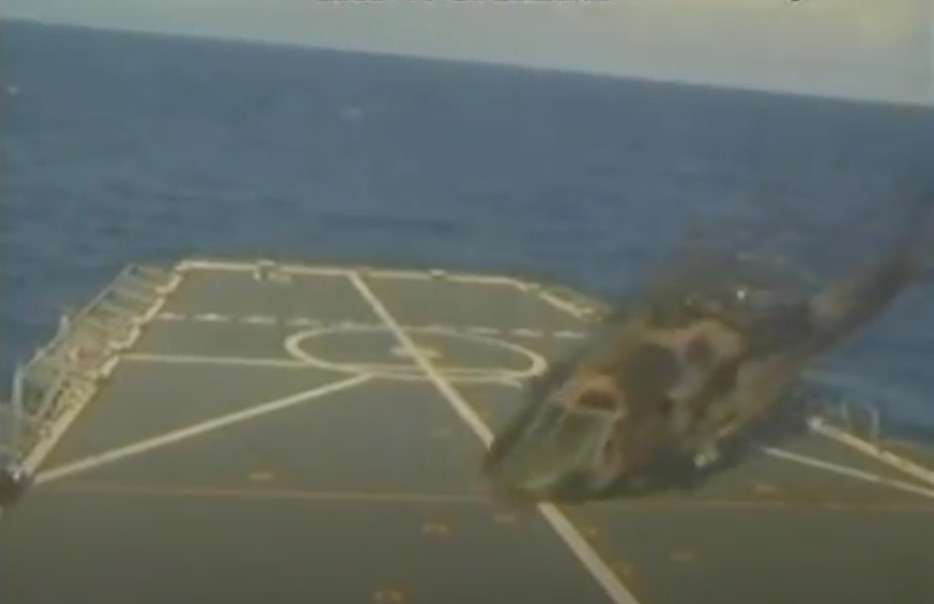
Right. The Sea King was too big to fit in a RAAF Hercules so long transits were sometimes required to get aircraft from one part of the continent to another – in this case from Nowra to Darwin, a flight of about 3200 km (2000 miles) – a two day journey.
This local news snippet tells the story of one Sea King stranded at Tennant Creek in 2007, about 1000 km (600 m) south of Darwin, when it arrived only to find supplies of JET-A1 had been discontinued. The crew had to remain there overnight while a tanker trucked fuel in from the nearest large depot at Alice Springs. The incident caused some political posturing, as would be expected.
As the RAN Sea King clicked over its 30th year of service, another notable milestone was marked too (left) – this time on a more personal basis. Lieutenant Commander Tanzi Lea achieved his 10,000th flying hour in Sea Kings…a momentous achievement unmatched by any other RAN pilot. The event was noted by Augusta-Westland and by HS817 Squadron. By an extraordinary coincidence, Lea had been on the same Sea King OFT as the first two Australian pilots (Bell and Craig) back in ’75, as a Sub Lieutenant RN. You can see him in the first group image on Page 1 of this photographic history, lurking in the back row second from the right.
The Sea King’s frenetic rate of effort didn’t slow in its final two years. Operation Pandang Assist was a case in point in 2009, where Kanimbla and her aircraft were sent to Sumatra for humanitarian reasons. Below: Lieutenant Stephen McConville from 817 Squadron prepares to embark Sea King 10 on the flight deck of Kanimbla, prior to flying. Under: A selection of images from Padang Assist.
Above: Job done! As Kanimbla heads for home, there’s time for both formal (left) and somewhat less formal (right) shots of Flight 2. Below. Larking aside, important jobs remain – such as this ‘FoD Plod’ where the deck is frequently scrutinised for any small loose objects that could be sucked into an engine intake. (Click any photo once to enlarge, twice for super enlargement).
Below: The Sea King entered its last year of service with another humanitarian mission, but this time on home soil. Battered by extensive rain, Queensland suffered extensive flooding which prompted Operation Queensland Flood Assist in January of 2011. Two 817 Squadron Sea Kings were positioned at Roma to assist. [Below]. Squadron maintainers scamper towards a hangar as the heavy rain sets in. Right [1]: PO ACMN Nick Anderson shows young Joshua and Kate the cockpit of one of the aircraft during a quiet moment. Right [2]: Forest Hill residents waiting for a transfer to Gratton to escape rising flood waters. Navy images by PO Damian Pawlenko.
Left. Hard on the heels of the QLD Flood mission came another: to transport HRH Prince William to regional towns in Victoria during part of his Oz visit of March 2011.
It was a welcome one for the Prince, who was able to spend some time in the font LH seat as he flew to Kerang and then again back to Albury. Pictured with the Prince are, L-R: CPO Kerwyn Ballico, LSA Ben McNeil, LEUT Paul Coxell, LtCdr Nick Bane RN, and 817 Squadron’s CO, CMDR Paul Moggach. You can read the story of that day here.
Left. Mid 2011 brought yet another milestone when the Sea King simulator, a quiet achiever in the training of dozens of pilots, turned 35. The date coincided with the 20th birthday of the Seahawk S70B simulator, which gives an indication of just long long was the overlap between the two aircraft. Pictured left are Bill Shurey, one of the original training team on the Sea Hawk Simulator, with Tony Baker, who helped set up the Sea King training simulator in the UK prior to it being shipped to Australia in 1976. (Image: South Coast Register 19Jun11). It was reported that even with its use-by date looming, the simulator was still running at over 99% of its operational capacity.
Below. One of the longer Search and Rescue (SAR) missions for 817 SQN occurred in May 2011, when a climber broke his ankle near the summit of Mt Glover. The extreme terrain meant only air extraction was possible, and no civilian helicopter could reach the locality. Two Sea Kings (to give mutual SAR support) were dispatched via Port Macquarie on 16 May, before making the long overwater transit to Lord Howe Island the following morning. The climber, who was not enjoying his honeymoon, was winched up having spent an uncomfortable night. The photos to the left give an idea of the remoteness of the site, even though it was not far from the Island’s airfield. The hovering Sea King can just be seen in the lower of the two images.
Below. The end of the line. CMDR Paul Moggach, the last of 817 Squadron’s Commanding Officers, pops a bottle of champagne to celebrate the end of his last flight, and the impending end of his command, of over 35 years of Sea King service, and the completion of another chapter in the Squadron’s 61-year history. He had much to be proud of. Right [1]: Guests gather for the decommissioning ceremony on 11 December 2011. Right [2]: CMDR Moggach watches as the White Ensign is folded, a symbolic moment of the ceremony.
Left. First and last. CMDR Eddie Bell, the first Commanding Officer of a newly Sea King equipped 817 Squadron, congratulates CMDR Paul Moggach, the last.
Below. Navy was originally hoping to sell the remaining Sea Kings as a job lot: five airworthy aircraft, a Simulator, seven engines and other spares. The sixth aircraft, Shark 07, was to be donated to the Fleet Air Arm Museum. Various articles appeared in aerospace magazines, but no buyer was found and the airframes languished for a year in RAN storage.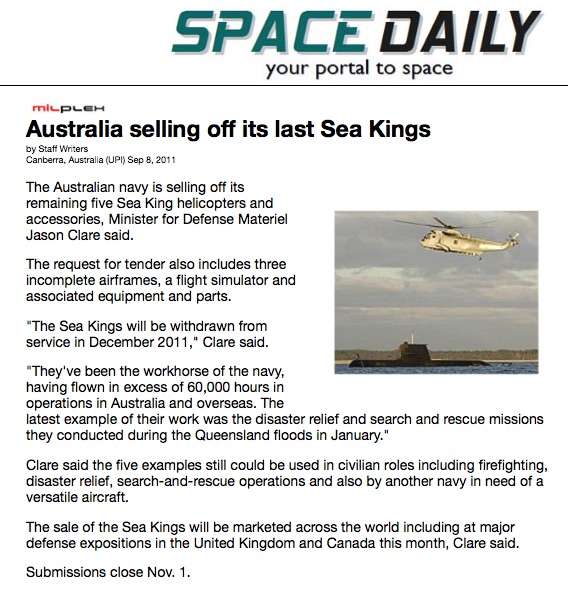
In early January of 2013 the Minister for Defence Materiel announced that a buyer had been found. They were not destined for scrap metal, as was erroneously reported at the time, but for spare parts. The buyer, Aerospace Logistics (ASL), had over 30 years experience in the supply, refurbishment and repair of aircraft spare parts. Below right. The job of stripping the aircraft began before they were shrink-wrapped and transported to Sydney for shipment to the UK. (Below left, with inset showing ASL blurb).
…and so the Sea King was gone. After more than a third of a century of service to the RAN and 60,000 flying hours, it surrendered to the newer MRH90 utility helicopter and the pages of history. Below. Of the thousands of Sea King photos we have seen, this one by LS Phot Damian Pawlenko sums it up in a single image: an aircraft that worked from its very first day until its last, and, more importantly, was able to adapt to whatever was demanded of it: from hunting submarines in oceans all over the world to a battle hardened helicopter in the deserts of the Middle East.
The Sea King only ever served on one Squadron, which, in turn, had no other types during that aircraft’s life. The Squadron’s motto was “Aude Facere” – Dare To Do. With the Sea King, it could, and did.


